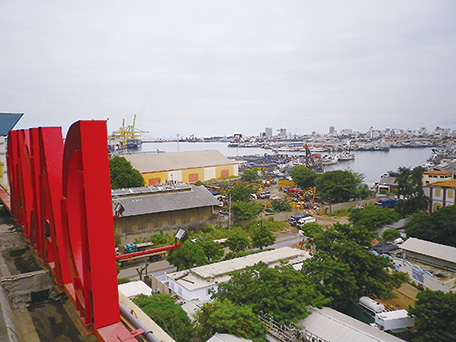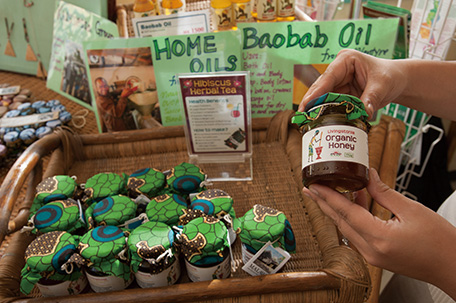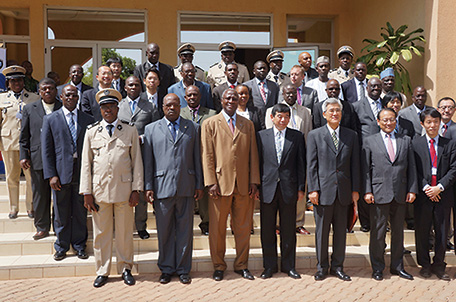(3) Cooperation between Trade, Investment, and Other Official Flows (OOF)
The private sector plays a leading role in the sustainable growth of developing countries. It is essential to revitalize private-sector activities such as the development of industry and the expansion of trade and investment. However, in developing countries beset by a variety of challenges, it can sometimes be difficult to develop capacities or set in place an environment for promoting trade and attracting private investment. Therefore, support from the international community is required.
< Japan's Efforts >

A view over a port in Dakar, Senegal. (Photo: Yosuke Kotsuji)
Japan utilizes ODA and Other Official Flows (OOF)* to support the advancement of small and medium enterprises (SMEs) in developing countries, transfer of Japan's industrial technology, and formulation of economic policies. In addition, Japan supports the development of the trade and investment environment and economic infrastructures in order to enhance the export capabilities and competitiveness of developing countries.
The Doha Round Negotiations (the Doha Development Agenda)* of the World Trade Organization (WTO) which started in 2001 also emphasizes the promotion of development through participation in the multilateral free trading system by developing countries. Japan has contributed to the trust fund set up within the WTO with an aim to improve the capacity of developing countries to engage in trade negotiations and participate in the global market, thereby gaining the ability to implement the WTO agreements.
Regarding access to the Japanese market, Japan has implemented the Generalized System of Preferences (GSP)(Note 10), which applies lower tariff rates, in order to encourage imports of products from developing countries. Japan provides duty-free quota-free access* for Least Developed Countries (LDCs)*. In addition, Japan also actively promotes Economic Partnership Agreements (EPAs)*, and tries to create an environment for economic growth in developing countries through liberalization of trade and investment.
In recent years, active discussions have taken place regarding Aid for Trade (AfT)* at various international organizations, including the WTO and the Organisation for Economic Co-operation and Development (OECD), among other fora, as a means of further promoting support by developed countries, including Japan. Japan implemented its unique measure called “Development Initiative for Trade*,” focusing on support for trade-related projects, twice since 2006. This Initiative is highly appreciated by numerous countries. Japan provides funds for the development of transportation networks vital to trade, including ports, roads, and bridges, as well as for projects to construct power plants and power grids, etc. Japan also provides technical cooperation in trade-related areas, including the training of customs officials and intellectual property rights experts.
Japan also provides assistance to small-scale production groups and small companies in developing countries for the One Village, One Product Campaign*. In addition, Japan supports developing countries in attracting private sector investment by identifying issues unique to those countries, and recommending measures to promote investment.

Products sold in a One Village One Product shop in Malawi. (Photo: Kenshiro Imamura / JICA)
Elsewhere, Japan is proactively engaged with the Regional Technical Group on Aid for Trade for Asia and the Pacific, which researches successful examples of development cooperation that has contributed to economic growth through exports in the Asia region. At the WTO Fourth Global Review of Aid for Trade held in July 2013 on the theme of “connecting to value chains,” examples of Japan's development cooperation which helped build international production and distribution networks in East Asia and contributed to regional economic growth were introduced as the outcome of the discussions of the Technical Group, and garnered high praise from participating countries. Furthermore, as a case of technical cooperation of the Ministry of Economy, Trade and Industry (METI), Japan provides support that contributes to the overseas expansion of Japanese companies, including the fostering of industrial human resources, employment promotion, and securing of sophisticated local talent, through corporate culture courses, job fairs, and other means organized in collaboration with local universities and other actors.
The Bali Package* achieved at the Ninth WTO Ministerial Conference in December 2013 incorporates trade facilitation. It is desirable that the Trade Facilitation Agreement* enters into force and is implemented at an early date. Japan has heretofore assisted developing countries with trade facilitation, and will continue to extend proactive support utilizing its knowledge and experience.
- *Other Official Flows (OOF)
- OOF refers to flows of funds to developing countries from the governments which are not considered to be ODA because the main purpose is not development. Examples include export credit, direct investment by governmental financial institutions, and financing of international organizations.
- *Doha Round Negotiations (the Doha Development Agenda)
- Doha Round Negotiations are negotiations between multiple WTO members aimed at liberalizing trade in a wide range of fields, including reduction/elimination of tariffs on industrial products and agriculture, forestry and fishery products, and deregulation in the service sector. One of their challenges is the development of developing countries through trade. At the Ninth WTO Ministerial Conference in December 2013, members agreed on such matters as the guidelines on rules of origin for promoting exports of least developed countries (LDCs) and the details of preferential treatment of services exports.
- *Least Developed Countries (LDCs)
- LDCs are countries classified by the United Nations to be particularly lagging in development even when compared to other developing countries, based on their income levels. LDCs meet certain criteria, including per capita gross national income (GNI) of $992 or less between 2008 and 2010. As of March 2013, there are 49 countries that have been so designated: Seven in Asia, two in the Middle East and North Africa, 34 in Sub- Saharan Africa, one in Latin America, and five in Oceania. (See this)
- *Duty-free quota-free access
- Duty-free quota-free access means measures implemented by developed countries to eliminate customs duties, quotas, and other obstacles to imports of products from least developed countries (LDCs). Japan has expanded the number of applicable products, and approximately 98% of products exported by LDCs to Japan can be imported without payment of duties and without quotas. (As of July 2013)
- *Economic Partnership Agreement (EPA)
- EPAs are comprehensive economic agreements with specific countries (or regions) that, in addition to free trade agreements (FTAs) that stipulate the liberalization of trade in goods and services such as the reduction/elimination of tariffs, include such areas as investment, movement of people, government procurement, protection of intellectual rights, rulemaking for competitive policies, and bilateral cooperation intended to enhance broad economic ties. These agreements are expected to further vitalize trade and investment between countries and contribute to economic growth.
- *Aid for Trade (AfT)
- AfT is assistance provided to developing countries to improve trade-related capabilities and to prepare and maintain infrastructures, for the purpose of aiding developing countries in achieving economic growth through the multilateral trading system under the WTO.
- *Development Initiative for Trade
- Development Initiative for Trade refers to comprehensive measures to support sustainable development of developing countries through trade. Japan provided assistance totaling approximately $17.6 billion in the three years from 2006 to 2008 and assistance totaling approximately $23.3 billion in the three years from 2009 to 2011. For developing countries to enjoy the benefits of the free trade system, not only must trade be liberalized, but it requires the three aspects of (i) production (improvement of the ability to produce competitive products), (ii) distribution and marketing (development of a domestic and overseas logistics system, including the distribution infrastructure), and (iii) purchasing (pioneering of markets). The aim is to combine means of assistance such as “knowledge and technology,” “funds,” “people,” and “systems” with these three aspects, and provide comprehensive support that connects producers and workers in developing countries to consumers both in the developed countries and developing countries.
- *One Village, One Product Campaign
- One Village, One Product Campaign is overseas utilization of an approach that began in Oita Prefecture, Japan, in 1979. The aim is to create jobs and revitalize the local community by developing unique local products through the utilization of local resources and traditional techniques. Efforts are made to focus on handicrafts, textiles, toys, and other attractive products that display the unique ethnic characteristics of developing countries in Asia and Africa, etc., and reach out to a wider range of people, thereby aiding in the expansion of exports of products from developing countries.
- *Bali Package
- Bali package is part of the Doha Round negotiations reached at the Ninth WTO Ministerial Conference in Bali in December 2013. The Doha Round negotiations, which started in 2001, have remained deadlocked due to clashes between emerging economies and developed countries, among other reasons. In order to achieve a breakthrough, new approaches have been explored, including the buildup of partial agreements. The Bali Package consists mainly of three fields: (1) Trade facilitation; (2) Part of the field of agriculture; and (3) Development. The Package decided to establish a work programme on the remaining issues of the Doha Round negotiations (e.g., agriculture, mining products, and services) by the end of 2014. (Subsequently, the deadline for establishing the work programme was extended to July 2015 at a special meeting of the WTO General Council.)
- *Trade Facilitation Agreement
- This agreement provides for the simplification and enhanced transparency of customs procedures aimed at trade promotion. The protocol to make this agreement a part of the WTO Agreement was adopted at a special meeting of the WTO General Council in November 2014. If this agreement is concluded, it will become the first multilateral agreement reached by all member states of WTO since its founding in 1995. According to preliminary estimates, the conclusion of the agreement is expected to increase GDP by $1 trillion annually.
- Note 10: This system applies tariff rates lower than the MFN rates (preferential tariff rates) to designated agricultural and fishery products and industrial products imported from developing countries, in order to increase export income and promote industrialization and economic development in developing countries.
| The West African Economic and Monetary Union (UEMOA)
Advisor custom policies for better processing of commercial exchange within UEMOA
Development of custom service for better processing within UEMOA
Individual Expert (October 2012 – Ongoing)

Participants in the first Japan-UEMOA high-level customs cooperation meeting held in June 2013 in Ouagadougou, the capital city of Burkina Faso. (Photo: JICA)
The West African Economic and Monetary Union (UEMOA)1 is a regional organization that consists of eight West African countries: Benin, Burkina Faso, Côte d'Ivoire, Guinea-Bissau, Mali, Niger, Senegal, and Togo. UEMOA aims to create a large-scale regional common market by establishing a common currency, trade and custom systems to facilitate intra-regional trade.
Although the population of each member country of UEMOA is not large by any means, the region as a whole is an attractive market with 100 million people. However, distribution within the region relies on road transport, which in turn raises transportation costs due to the inefficiency of the custom processes at the borders. This has been one of the factors that prevent trade from gaining momentum in the region.
In order to solve this problem, UEMOA has been promoting efforts to harmonize and simplify the custom processes, such as by introducing One-Stop Border Posts (OSBP)2. UEMOA is also working to vitalize the regional economy and enhance the competitiveness of member countries through initiatives, including the proper collection of taxes by customs and smuggling prevention measures.
To meet these needs, Japan has dispatched two experts on custom services to UEMOA to conduct analysis and give advice on the issues related to international corridor3 and custom processes (including the management and facilitation of OSBP) in the region. In addition, Japan provides support for UEMOA's efforts to establish the common market by giving advice on the drafting of a strategy for the facilitation of trade within the region.
At the same time, Japanese companies have little information on francophone West Africa compared to the rest of Africa. Japan provides support to enable more Japanese companies to expand their businesses into the UEMOA area, such as the provision of information on the custom systems in the region by the experts dispatched by way of JICA.
(As of August 2014)
*1 UEMOA: L'Union Economique et Monétaire Ouest-African. All UEMOA countries are French-speaking.
*2 A system to facilitate more efficient border procedures, in which two countries that share the border jointly conduct at one time immigration/departure procedures and customs inspections on the road.
*3 Transport infrastructure such as roads and bridges that connect international ports and inland areas in order to facilitate the movement of people and goods across borders. Typical examples include support for hard infrastructure such as ports, roads, power and water supply, and soft infrastructure such as the improvement of the management of OSBP.
